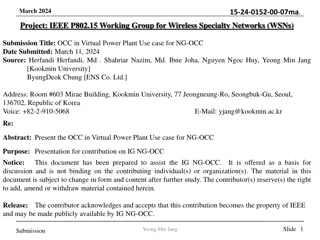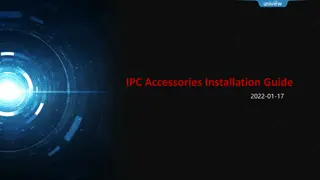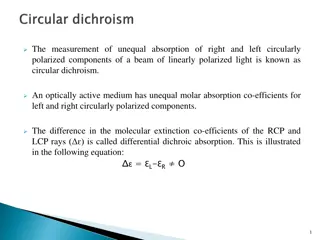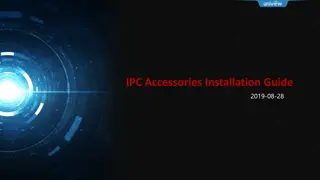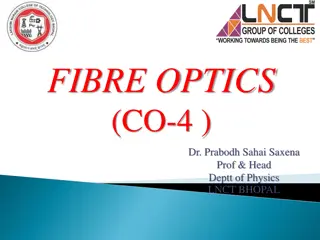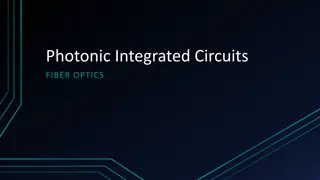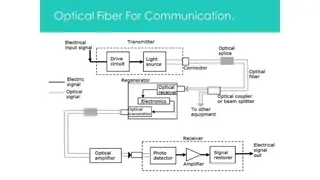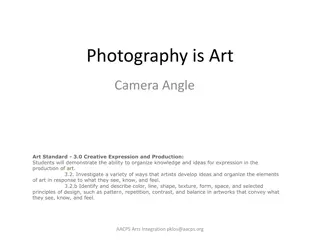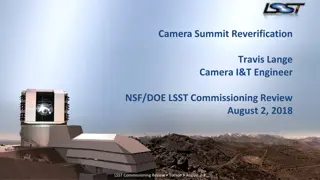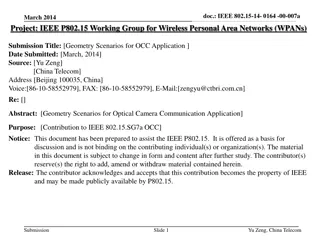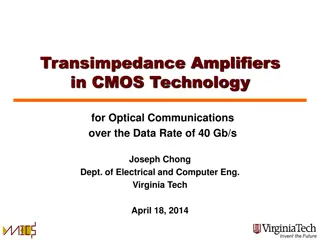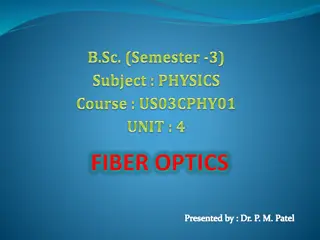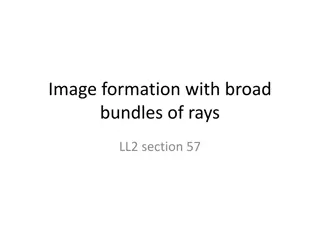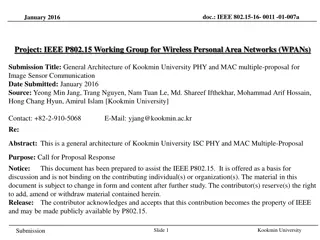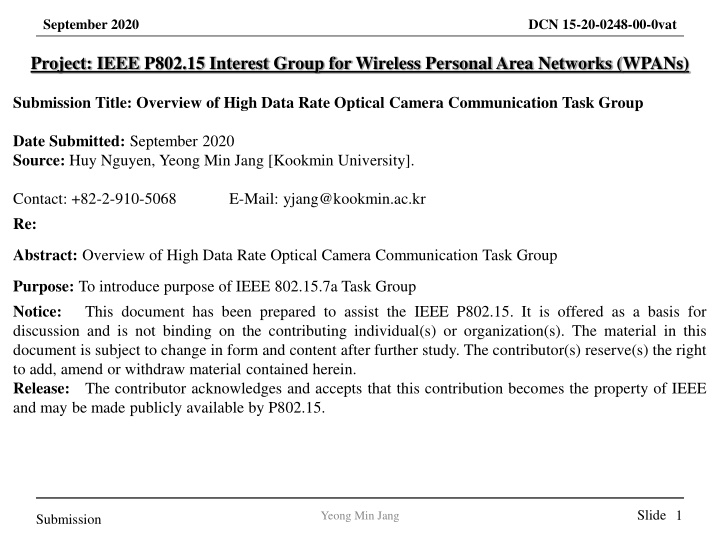
Advanced Optical Camera Communication Technologies Overview
Explore cutting-edge Optical Camera Communication (OCC) technologies utilizing high-speed cameras and image sensors for enhanced data transmission. Learn about various OCC techniques like Rolling Shutter-based OCC and Screen Modulation-based OCC, offering high data rates and unique advantages for communication systems.
Download Presentation

Please find below an Image/Link to download the presentation.
The content on the website is provided AS IS for your information and personal use only. It may not be sold, licensed, or shared on other websites without obtaining consent from the author. If you encounter any issues during the download, it is possible that the publisher has removed the file from their server.
You are allowed to download the files provided on this website for personal or commercial use, subject to the condition that they are used lawfully. All files are the property of their respective owners.
The content on the website is provided AS IS for your information and personal use only. It may not be sold, licensed, or shared on other websites without obtaining consent from the author.
E N D
Presentation Transcript
September 2020 DCN 15-20-0248-00-0vat Project: IEEE P802.15 Interest Group for Wireless Personal Area Networks (WPANs) Submission Title: Overview of High Data Rate Optical Camera Communication Task Group Date Submitted: September 2020 Source: Huy Nguyen, Yeong Min Jang [Kookmin University]. Contact: +82-2-910-5068 Re: E-Mail: yjang@kookmin.ac.kr Abstract: Overview of High Data Rate Optical Camera Communication Task Group Purpose: To introduce purpose of IEEE 802.15.7a Task Group Notice: This document has been prepared to assist the IEEE P802.15. It is offered as a basis for discussion and is not binding on the contributing individual(s) or organization(s). The material in this document is subject to change in form and content after further study. The contributor(s) reserve(s) the right to add, amend or withdraw material contained herein. Release: The contributor acknowledges and accepts that this contribution becomes the property of IEEE and may be made publicly available by P802.15. Slide 1 Yeong Min Jang Submission
September 2020 DCN 15-20-0248-00-0vat Introduction Unlike VLC or Li-Fi communications that use PDs as receivers, the OCC technique uses an image sensor as the detector to receive data. OCC aims to deliver data from the light sources to the camera. Artificial lights (LED light) are available everywhere human being live, and cameras too. The existing infrastructure shall be an advantage of OCC for the market acceptance. Slide 2 Yeong Min Jang Submission
September 2020 Classification of OCC Technologies DCN 15-20-0248-00-0vat High Frame Rate Processing High-speed camera-based transmission protocols are related to multiple- input-multiple-output (MIMO) technique, which achieves data rates of tens of kbps from LED arrays Reference architecture using high-speed camera Slide 3 Yeong Min Jang Submission
September 2020 Classification of OCC Technologies DCN 15-20-0248-00-0vat Rolling Shutter-based OCC Despite having low frame rates, rolling-shutter cameras are beneficial for non-flicker systems, as the rolling shutter mechanism sequentially exposes the pixel lines to the incoming light at a high sampling rate. Example of rolling shutter based OCC technique Slide 4 Yeong Min Jang Submission
September 2020 Classification of OCC Technologies DCN 15-20-0248-00-0vat Screen Modulation-based OCC The data rate of these screen-camera systems can achieve up to Mbps by taking advantage of high spatial resolution at both Tx and Rx Example of rolling shutter based OCC technique Slide 5 Yeong Min Jang Submission
September 2020 Classification of OCC Technologies DCN 15-20-0248-00-0vat Region-of-Interest signaling This technology is applied for detecting and tracking the light source. Example of RoI signaling based OCC technique Slide 6 Yeong Min Jang Submission
September 2020 DCN 15-20-0248-00-0vat Overview IEEE 802.15.7-2018 IEEE 802.15.8-2018 standard defines a physical layer (PHY) and medium access control (MAC) sublayer for short-range optical wireless communications (OWC) in optically transparent media using light wavelengths from 10.000 nm to 190 nm. IEEE 802.15.7-2018 standard provides a global standard for short-range OWC. The standard provides the following: o Access to several hundred terahertz of unlicensed spectrum. o Immunity to electromagnetic interference and non-interference with radio frequency systems. o For visible light systems, additional security by allowing the user to see the communication channel, Communication augmenting and complementing existing services (e.g., illumination, display, indication, decoration). Slide 7 Yeong Min Jang Submission
September 2020 Purpose of IEEE 802.15.7a Task Group DCN 15-20-0248-00-0vat Scope of task group IEEE 802.15.7a Task Group amendment specifies a high-rate Optical Camera Communications (OCC) Physical Layer (PHY) using light wavelengths from 10.000 nm to 190 nm in optically transparent media. It is capable of delivering data rates up to 100 Mbit/s and is designed for point-to- point and point-to-multipoint communication. Maintaining connectivity during high mobility (speeds up to 350 km/h), Flicker mitigation. Radio Frequency (RF) co-existence, and a communication range of up to 200 m. Multiple-Input-Multiple-Output (MIMO) is utilized to deal with high-levels of optical interference while maintaining high-rate data transmission. Slide 8 Yeong Min Jang Submission
September 2020 Purpose of IEEE 802.15.7a Task Group DCN 15-20-0248-00-0vat Purpose of task group IEEE 802.15.7a Task Group standard provides: o Access to unlicensed spectrum. o Inherent communication security due to inability to penetrate through optically opaque walls. o Data delivery without using RF spectrum. o Apply MIMO and Artificial intelligence (AI)-based PHY and MAC layers. o Communication augmenting and complementing existing services (such as illumination, indication, localization, etc.) Slide 9 Yeong Min Jang Submission


